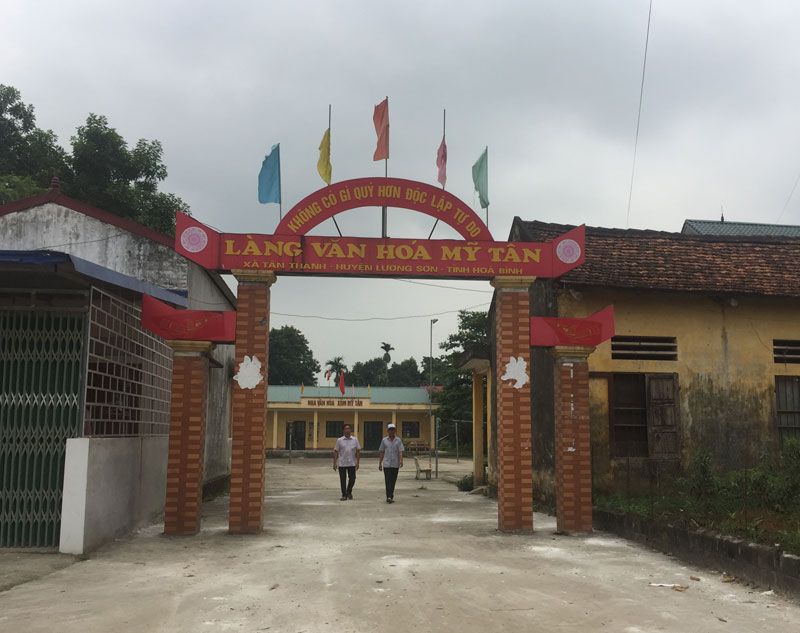
(HBO) - Mr. Bui Van Dien, the Vice Chairman of the People's Committee of Tan Thanh commune says that now Tan Thanh commune has a cultural house and a central stadium, 100% of hamlets have a cultural house, a sports ground, five out of the eleven hamlets have been recognized as the cultural villages and over 81% of households have earned the title of the cultural families.

The cultural house of Tan My hamlet, Tan Thanh commune
(Luong Son) has been invested and built to meet the community's living needs.
Every year, the Steering Committee of the movement "All
People unite to build a cultural life” issues the documents to implement in
accordance with the situation in each stage. The Steering Committee has beeb
directing the hamlets to build and modify the conventions and the regualtions
based on the general development situation, contributing to the implementation
of civilized life in weddings, mournings and festivals in association with
building a healthy cultural environment.
In particular, the commune has promoted the propaganda and
mobilized the people to unite, helping each other to develop the economy,
reduce poverty, and jointly build new rural areas. The movement of building the
cultural families and villages has been widely deployed and consented by the
people. In particular, in the implementation of building the new rural areas,
with the policy of "State and people work together", the households
have actively donated land for the rural roads and the
social welfare projects. Currently, the inter-village and the inter-commune
roads have been hardened, the cultural houses, schools, health stations along
with other cultural institutions have been invested, upgraded, improving and
improved, contributing significantly to the successful implementation of
development targets of the socio-economic resolution that the was proposed in
the Resolution of the 23rd Party Congress of the Communist Party
In order to make the movement more effective, the communal
Steering Committee will continue to promote the propaganda and mobilize the
people to perform the weddings, the mournings and the festivals according to
the civilized lifestyle. It is necessary to raise the awareness and
self-consciousness of the families in building a cultural family, building and
maintaining the title of the cultural residential area. It is also important to
build models of good people, good deeds and advanced examples so that they
become the core nucleus in the population area and motivate people to excitedly
take part in the production emulation, contributing to completing the
objectives of the local socio-economic development.
With an increasingly vibrant and widespread emulation movement aimed at building cultured residential areas and cultured families, Yen Thuy District has been making steady progress toward improving both the material and spiritual well-being of its people, while fostering a civilized, prosperous, beautiful, and progressive community.
Once lacking recreational spaces and community facilities, Residential Group 2 in Quynh Lam Ward (Hoa Binh City) has recently received attention for the construction of a new, spacious, and fully equipped cultural house. The project followed the model of state support combined with public contributions in both labor and funding.
The "All people unite to build cultural life" movement, which has been effectively integrated with Kim Boi district’s socio-economic development goals, is fostering a lively spirit of emulation across local residential areas, hamlets, villages, public agencies, and enterprises. In addition, through the initiative, traditional cultural values are being preserved and promoted, while community solidarity and mutual support in poverty reduction and economic development are being strengthened.
A working delegation of the Hoa Binh provincial People’s Committee led by its Permanent Vice Chairman Nguyen Van Toan on June 11 inspected the progress of a project to build the Mo Muong Cultural Heritage Conservation Space linked to tourism services in Hop Phong commune, Cao Phong district.
Born and growing in the heroic land of Muong Dong, Dinh Thi Kieu Dung, a resident in Bo town of Kim Boi district, in her childhood was nurtured by the sweet lullabies of her grandmother and mother. These melodies deeply imprinted on her soul, becoming an inseparable part of her love for her ethnic group's culture. For over 20 years, this love for her hometown has driven Dung to research, collect, and pass down the cultural values of the Muong people to future generations.
In the final days of May, the Ethnic Art Troupe of Hoa Binh Province organized performances to serve the people in remote, mountainous, and particularly disadvantaged areas within the province. These were not just ordinary artistic shows, but they were the meaningful journeys aimed at spreading cultural values, enhancing the spiritual life of the people and contributing to the preservation of ethnic minority cultural identities.



